Traffic Police Hand Signals
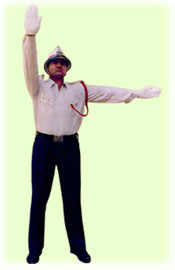 |
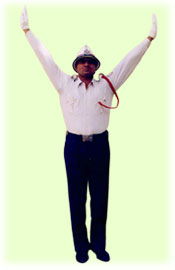 |
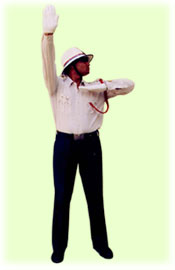 |
| To stop vehicles approaching simultaneously from front and behind. | To stop vehicles approaching simultaneously from right and left. | To start vehicle approaching from left. |
 |
 |
 |
| To start vehicles coming from right. | To change sign. | To start one sided vehicles. |
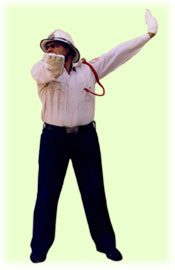 |
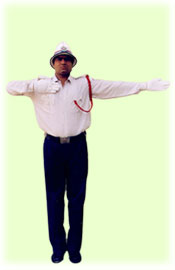 |
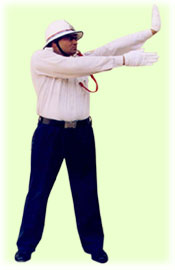 |
| To start vehicles on T-Point. | To give VIP salute. | To manage vehicles on T-Point. |
 |
 |
 |
 |
 |
| Straight Prohibitedor no entry | One way signs-vehicles prohibited in one direction | Vehicles prohibited in both direction | All vehicles prohibited | |
 |
 |
 |
 |
 |
|
Trucks prohibited
|
Cycles prohibited
|
Horns prohibited
|
Bullock carts and hand
carts direction |
Bullock carts direction
|
 |
 |
 |
 |
 |
|
Tongas direction
|
Hand carts direction
|
Pedestrians prohibited
|
Right turn prohibited
|
Left turn prohibited
|
 |
 |
 |
 |
 |
| U- turn prohibited | Overtaking prohibited | No Parking | No stopping or standing | Speed limit |
 |
 |
 |
 |
 |
| Width limit | Height limit | Length limit | Load limit | Axle load limit |
 |
 |
 |
 |
 |
|
Compulsory bus stop
|
Restriction ends sign
|
Compulsory cycle track
|
Compulsory sound horn
|
Compulsory keep left
|
 |
 |
 |
 |
 |
|
Compulsory turn left
|
Compulsory turn right ahead
|
Compulsory ahead or turn right
|
Compulsory ahead or turn left
|
Compulsory ahead
|
 |
 |
|||
| Stop | Give way | |||
 |
 |
 |
 |
 |
| Right hand curve | Left hand curve | Right hair pin bend | Left hair pin bend | Right reverse bend |
 |
 |
 |
 |
 |
|
Left reverse bend
|
Steep ascent
|
Steep descent
|
Narrow road ahead
|
Road wideness ahead
|
 |
 |
 |
 |
 |
|
Narrow Bridge
|
Slippery Road
|
Loose Gravel
|
Cycle Crossing
|
Pedestrian Crossing
|
 |
 |
 |
 |
 |
| School Ahead | Men at Work | Cattle | Falling Rocks | Ferry |
 |
 |
 |
 |
 |
| Cross Road | Gap in Median | Side Road Right | Side Road Left | Y-Intersection |
 |
 |
 |
 |
 |
|
Y-Intersection
|
Y-Intersection
|
T-Intersection
|
Staggered Intersection
|
Staggered Intersection
|
 |
 |
 |
 |
 |
|
Major road ahead
|
Major road ahead
|
Roundabout
|
Dangerous dip
|
Hump or rough road
|
 |
 |
 |
 |
 |
| Barrier ahead | 200 meters | 50-100 meters | 200 meters | 50-100 meters |
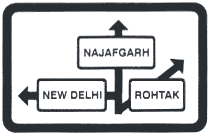 |
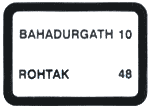 |
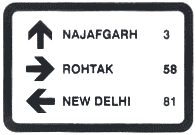 |
| Advanced direction sign | Re-assurance sign | Destination sign |
 |
 |
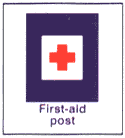 |
|
Direction sign
|
Place identification sign
|
First aid post
|
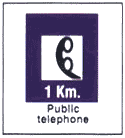 |
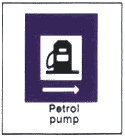 |
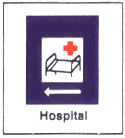 |
|
Public telephone
|
Petrol pump
|
Hospital
|
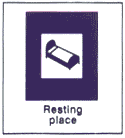 |
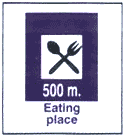 |
 |
| Resting place | Eating place | First-aid post |
 |
 |
 |
|
Park this Side
|
Parking both sides
|
Parking lot Scooters and motorcycle
|
 |
 |
 |
|
Parking lot Cycles
|
Parking lot Taxis
|
Parking lot Auto rickshaws
|
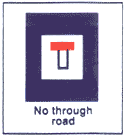 |
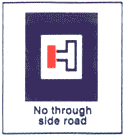 |
 |
|
No through road
|
No through side road
|
Parking lot Cycle rickshaws |
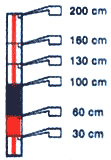 |
||
| Flood gauge |
| STOP Stop well before the stop line, and don't crowd the intersection. This not only obstructs a clear view of the intersection for other road users, but also make the zebra crossing unsafe for the pedestrians. You are allowed to turn left at the red signal unless there is a sign specifically forbidding you to do so. When turning, yield the right of way to pedestrians and vehicles from other directions. | 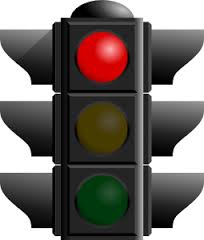 |
| BE ALERT The Amber light gives time to vehicles to clear the road when the signal is changing from green to red. If caught in the Amber signal in the middle of a large road crossing do not press your accelerator in panic but do continue with care. | 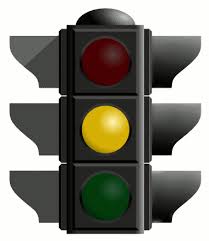 |
| GO If first in line, do not go tearing off at the green signal but pause to see whether vehicles from other directions have cleared the road. Sometimes you are allowed to turn left or right too, unless separate signs exist for each direction. if turning, yield the right of way to pedestrians and vehicles from other directions. |
 |
| STEADY GREEN ARROW SIGNAL Proceed with caution in the direction indicated by the arrows. Remember that you must yield to all pedestrians and vehicles already in the intersection. | 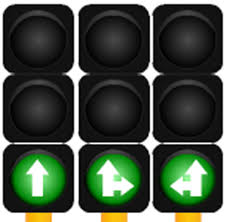 |
| FLASHING RED SIGNAL You must come to a complete stop, yield to all other traffic and to pedestrians. Proceed only when the way is clear. |  |
| FLASHING AMBER SIGNAL You should slow down and proceed with caution. |  |
| Bare roads will lead to total vehicular confusion. Markings are painted on the road to direct, guide and regulate the road user. Road markings include all lines patters, words and colours applied on or attached to the road surface or kerb, for the said purpose |  |
| Traffic paints are commonly used for road markings. Other materials such as, road studs, cat's eyes and thermoplastic strips also find their application in road markings. These markings promote road safety and ensure smooth flow of traffic. Sometimes, road markings are used to supplement the message of road signs and other devices. |  |
| White is generally used for carriageway (road) markings except those indicating restrictions for which yellow markings are used. White or yellow together with black are used for kerb and object marking. |  |
|
Centre line : Centre line marking for a two lane road On undivided two-way roads, the centre line separates the opposing streams of traffic and facilitates their movements. The centre line can be a single broken line, a single continous solid line (barrier line), a double solid line or a combination of solid line and broken line. Single and double solid lines, whether white or yellow, must not be crossed or even straddled. On a road with two centre lines, of which one is solid and the other broken, the solid line has significance only it it is on the left side of the combination as viewed by the driver. In such a case, the driver must be careful not to cross or straddle the centre line. |
 |
|
Lane line : Lane line and broken centre line |
 |
|
Centre barrier lines : |
|
| Centre barrier line marking for a four lane road |  |
| Centre barrier line marking for a six lane road |  |
|
Double white/yellow lines Double Continuous lines are used where visibility is restricted in both directions. |
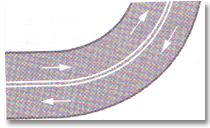 |
|
Combination of solid and broken lines
|
 |
|
Stop Line A stop line is a single solid transverse line painted before the intersecting edge of the road junction/ intersection.This line indicates where you are required to stop when directed by traffic officer, traffic light of stop sign. Where a pedestrian crossing is provided, the stop line is marked before the pedestrian crossing. |
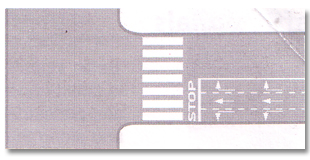 |
|
Give way Line The give way line is usually a double dotted line marked transversely at junctions. These lines are generally supplemented by a reverse triangle give way sign painted on the road surface before the dotted lines or by a road sign installed beside the marking. Give way to traffic on the main approaching road. |
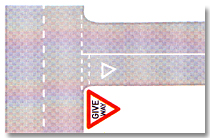 |
|
Border or edge lines These are continuous lines at the edge of the carriageway and mark the limits of the main carriageway upto which a driver can safely venture. |
 |
|
Parking prohibited lines A solid continuous yellow line painted on the kerb or edge of the carriageway along with a "No-parking" sign indicates the extent of no-parking area. |
 |
|
Yellow box junctions or keep clear These are yellow crossed diagonal lines within the box. The vehicles should cross it only if they have a clear space available ahead of the yellow box. In this marked area vehicles must not stop even briefly. |
 |
|
Pedestrian Crossings These are alternate black and white stripes painted parallel to the road generally known as zebra crossing. Pedestrians must cross only at the point where these lines are provided and when the signal is in their favour at controlled crossings.You must stop and give way to pedestrians at these crossings. Pedestrian crossings are marked to facilitate and give the right of way to pedestrians. |
 |

